Home > SightseeingList > Ancient Pompeii (Pompei Scavi)
Home > SightseeingList > Ancient Pompeii (Pompei Scavi)

The city of Pompeii was an ancient Roman town. It was mostly destroyed and buried of ash and pumice in the eruption of Mount Vesuvius in 79 AD. The largest archaeological site in Europe, today Pompeii is a UNESCO World Heritage Site. The cities remained buried and undiscovered for almost 1700 years until excavation began in 1748 and due to its excellent state of preservation it has given an invaluable insight into the Roman world and may lay claim to being the richest archaeological site in the world in terms of the sheer volume of data available to scholars. Yet at Pompeii we still have still a wealth of evidence - architecture, wall-paintings and mosaics, domestic artefacts - of a kind that is rarely found at other archaeological sites. And this evidence provides a unique insight into the lives of ordinary Romans in the first century AD.

It is a temple dedicated to the Greek and Roman god Apollo. It is believed to have been built in the 5th century BC. The temple itself, a peripteros with 48 Ionic columns, was on a high podium and entered up an imposing set of steps, in a fusion of Greek and Italic architectural ideas.
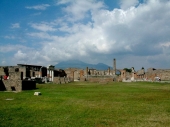
It was a fundamental role in the political, religious, and economic life of the city.
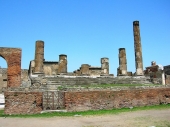
It dates back to 2nd Century BC and shows a majestic podium with a staircase and the cella standing out on top; it housed the statue of Jupiter -of which only the head remains- dating back to approx.
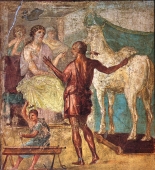
It is one of the most famous of the luxurious residences. The major fresco decorations enliven the peristyle and its living spaces and the triclinium or dining hall.
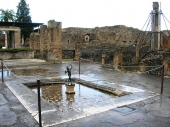
It was one of the largest, and most impressive private residences built during the 2nd century BC and housed many great pieces of art. It is portrayed while dancing and was placed there as a decoration for the impluvium, a shallow pool located in the atrium to collect rainwater.

It was a 5000-seat theatre built the 2nd-century-BC.
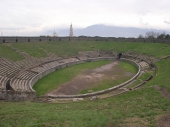
It is Roman amphitheatre built around 80 BC. It could seat around 20,000 people, and served not only Pompeii but also the inhabitants of surrounding towns.
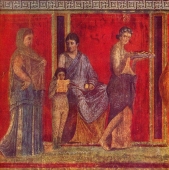
It is a well preserved ruin of a Roman Villa which lies some 400 metres northwest of Pompeii. The Villa is named for the paintings in one room of the residence. This space may have been a triclinium, and is decorated with very fine frescoes.
| Pompeii is only 17 miles (28 km) from Naples and can be accessed by local train, which runs every 30 minutes. Napoli-Sorrento line it takes 30 to 40 minutes to get to Pompeii from either Naples or Sorrento. |
Near